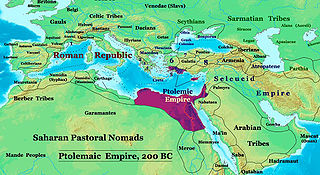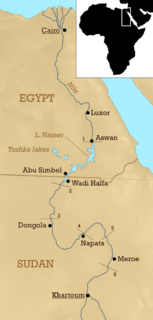 W
WThe Ptolemaic Kingdom was an ancient Hellenistic state based in Egypt. It was founded in 305 BC by Ptolemy I Soter, a companion of Alexander the Great, and lasted until the death of Cleopatra in 30 BC. Ruling for nearly three centuries, the Ptolemies were the longest and final dynasty in ancient Egyptian history.
 W
WBanias is an ancient site that developed around a spring once associated with the Greek god Pan. It is located at the foot of Mount Hermon, north of the Golan Heights. The spring is the source of the Banias River, one of the main tributaries of the Jordan River. Archaeologists uncovered a shrine dedicated to Pan and related deities, and the remains of an ancient city founded sometime after the conquest by Alexander the Great and inhabited until 1967; the ancient city was mentioned in the Gospels of Matthew and Mark by the name of Caesarea Philippi.
 W
WThe Berlin Green Head is an ancient Egyptian statue head made from greenschist and housed in the Egyptian Museum of Berlin, not far from the Nefertiti Bust. It has been considered the work of a highly skilled ancient Egyptian sculptor, as well as one of the most famous and credited pieces of art from the Late and Ptolemaic periods of ancient Egypt.
 W
WRosetta or Rashid is a port city of the Nile Delta, 65 km (40 mi) east of Alexandria, in Egypt's Beheira governorate. The Rosetta Stone was discovered there in 1799.
 W
WThe Bust of Cleopatra VII is a granite bust currently on display in the Gallery of Ancient Egypt at the Royal Ontario Museum (ROM). It is believed to have been discovered in Alexandria, Egypt at the site of Cleopatra's sunken palace on the island of Antirhodos. The bust was purchased by the ROM's founder Charles Trick Currelly while on expedition in Egypt in the early 20th Century.
 W
WCaesarea Philippi was an ancient Roman city located at the southwestern base of Mount Hermon. It was adjacent to a spring, grotto, and related shrines dedicated to the Greek god Pan. Now nearly uninhabited, Caesarea is an archaeological site in the Golan Heights.
 W
WCoele-Syria alternatively Coelo-Syria or Coelosyria, was a region of Syria in classical antiquity. It probably derived from the Aramaic word for all of the region of Syria, but it was most often applied to the Beqaa Valley between the Lebanon and the Anti-Lebanon mountain ranges. The area is now part of the modern-day Syria and Lebanon.
 W
WThe Cup of the Ptolemies, also known as the Cup of Saint Denis, is an onyx cameo two-handled cup, or kantharos. The cup, decorated with Dionysiac vignettes and emblems, was carved at some point in Classical Antiquity, probably in Alexandria. Eventually, it found its way into the treasury of the French kingdom, before it was donated to the abbey of St. Denis. During the Middle Ages, it was used as a Christian chalice, and lavish mounts were added, with Latin inscriptions. In 1804, the cup was stolen, and the mounts were lost, although the cup itself was recovered. It is now in the Cabinet des Médailles at the Bibliothèque Nationale de France, Paris.
 W
WThe Esquiline Venus, depicting the goddess Venus, is a smaller-than-life-size Roman nude marble sculpture of a female in sandals and a diadem headdress. It is widely viewed as a 1st-century AD Roman copy of a Greek original from the 1st century BC. It is also a possible depiction of the Ptolemaic ruler Cleopatra VII.
 W
WThe Gonzaga Cameo is a Hellenistic engraved gem; a cameo of the capita jugata variety cut out from the three layers of an Indian sardonyx, dating from perhaps the 3rd century BC. It was a centrepiece of the Gonzaga collection of antiquities, first described in a 1542 inventory of Isabella d'Este's collection as representing Augustus and Livia. The figures were later identified as Alexander the Great and Olympias, Germanicus and Agrippina the Elder, Nero and Agrippina the Younger, and many other famous couples of antiquity. The male figure on the cameo is clad in the attributes of Alexander, including a laurel-wreathed helmet, and wears a gorgoneion. His other aegis represents a bearded head, probably that of Zeus Ammon. The man's laurel wreath is crowned by a snake which suggests the uraeus. The contrasting male and female profiles were in all probability intended to suggest Zeus and Hera. The brown necklace is a later addition masking that the cameo was, at some point, broken in half.
 W
WThe Greek Magical Papyri is the name given by scholars to a body of papyri from Graeco-Roman Egypt, written mostly in ancient Greek, which each contain a number of magical spells, formulae, hymns, and rituals. The materials in the papyri date from the 100s BCE to the 400s CE. The manuscripts came to light through the antiquities trade, from the 1700s onward. One of the best known of these texts is the Mithras Liturgy.
 W
WInsinger Papyrus is a papyrus find from ancient Egypt and contains one of the oldest extant writings about Egyptian wisdom teachings (Sebayt). The manuscript is dated to around the 2nd century AD and the main part is kept at the Rijksmuseum van Oudheden in Leiden.
 W
WThe Palestrina Mosaic or Nile mosaic of Palestrina is a late Hellenistic floor mosaic depicting the Nile in its passage from the Blue Nile to the Mediterranean. The mosaic was part of a Classical sanctuary-grotto in Palestrina, a town east of Ancient Rome, in central Italy. It has a width of 5.85 metres and a height of 4.31 metres and provides a glimpse into the Roman fascination with ancient Egyptian exoticism in the 1st century BC, both as an early manifestation of the role of Egypt in the Roman imagination and an example of the genre of "Nilotic landscape", with a long iconographic history in Egypt and the Aegean.
 W
WCoinage of the Ptolemaic Kingdom was in use during the last dynasty of Egypt and, briefly, during Roman rule of Egypt.
 W
WThe Ptolemaic cult of Alexander the Great was an imperial cult in ancient Egypt in the Hellenistic period, promoted by the Ptolemaic dynasty. The core of the cult was the worship of the deified conqueror-king Alexander the Great, which eventually formed the basis for the ruler cult of the Ptolemies themselves. The head priest of the cult was the chief priest in the Ptolemaic Kingdom, and years were dated after the incumbents.
 W
WPtolemy Philadelphus in the Library of Alexandria is an 1813 oil on canvas painting by Vincenzo Camuccini. It is now in the National Museum of Capodimonte in Naples.
 W
WSyracusia was an ancient Greek ship sometimes claimed to be the largest transport ship of antiquity. She was reportedly too big for any port in Sicily, and thus only sailed once from Syracuse in Sicily to Alexandria in the Ptolemaic Kingdom of Egypt, whereupon she was given as a present to Ptolemy III Euergetes. The exact dimension of Syracusia is unknown, Michael Lahanas put it at 55 m long, 14 m wide, and 13 m high.
 W
WThe location of the tomb of Alexander the Great is an enduring mystery. Shortly after Alexander's death in Babylon, the possession of his body became a subject of negotiations between Perdiccas, Ptolemy I Soter, and Seleucus I Nicator. According to Nicholas J. Saunders, while Babylon was the "obvious site" for Alexander's resting place, some favored interring the ruler in the Argead burial at Aegae, modern Vergina. Aegae was one of the two originally proposed resting places, according to Saunders, the other being Siwa Oasis and in 321 BC Perdiccas presumably chose Aegae. The body, however, was hijacked en route by Ptolemy I Soter. According to Pausanias and the contemporary Parian Chronicle records for the years 321–320 BC, Ptolemy initially buried Alexander in Memphis. In the late 4th or early 3rd century BC, during the early Ptolemaic dynasty, Alexander's body was transferred from Memphis to Alexandria, where it was reburied.
 W
WThe Triakontaschoinos, Latinized as Triacontaschoenus, was a geographical and administrative term used in the Greco-Roman world for the part of Lower Nubia between the First and Second Cataracts of the Nile, which formed a buffer zone between Egypt and later Rome on the one hand and Meroe on the other hand. The northern part of this area, stretching from the First Cataract south to Maharraqa was known as the Dodekaschoinos or Dodecaschoenus. In the Ptolemaic and Roman periods the Dodekaschoinos was often annexed to Egypt or controlled from it, and the rest of the Triakontaschoinos sometimes was as well.
 W
WTryphé -- variously glossed as "softness", "voluptuousness", "magnificence" and "extravagance", none fully adequate—is a concept that drew attention in Roman antiquity when it became a significant factor in the reign of the Ptolemaic dynasty. Classical authors such as Aeschines and Plutarch condemned the tryphé of Romans such as Crassus and Lucullus, which included lavish dinner parties and ostentatious buildings. But there was more to Ptolemaic tryphé than dissipative excess, which after all can be pursued in residential or geographical seclusion, and for purely private purposes. It was a component of a calculated political strategy, in that it deployed not just conspicuous consumption but also conspicuous magnificence, beneficence and feminine delicacy, as a self-reinforcing cluster of signal propaganda concepts in the Ptolemaic dynasty.